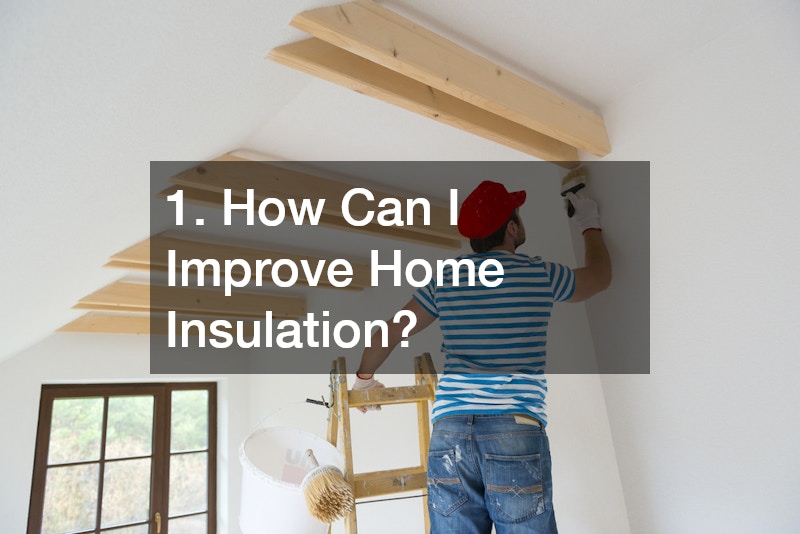Home renovation has evolved beyond aesthetic improvement—today, it’s about creating environments that promote comfort, safety, and efficiency. Modern homeowners are increasingly focused on upgrades that not only look appealing but also enhance the overall quality of living. From better insulation and lighting to smart technology and sustainable materials, renovation strategies have become more holistic and intentional.
Comfortable living spaces are those that balance temperature, light, and air quality while ensuring every area functions seamlessly. At the same time, safety upgrades protect your investment, prevent accidents, and ensure long-term durability. Whether you’re considering small updates or a full-scale renovation, adopting modern techniques can make a remarkable difference in your daily life.
This article explores practical and innovative strategies to help homeowners improve insulation, boost energy efficiency, enhance indoor air quality, and increase security. Each section dives into essential renovation tips supported by expert insights. You’ll also learn how working with specialized professionals—such as contractors, designers, and tradespeople—can elevate the results while ensuring safety standards are met. By combining comfort, innovation, and responsibility, you can turn your home into a space that reflects both modern living and lasting security.
1. How Can I Improve Home Insulation?

Effective insulation is one of the most valuable home renovations you can invest in for improving comfort and reducing energy bills. Proper insulation keeps your indoor temperature stable year-round—cool in the summer and warm in the winter—while minimizing the strain on your HVAC system. Insulation upgrades also help prevent drafts, condensation, and moisture buildup that can lead to structural damage or mold.
If your home feels unevenly heated or cooled, or if your energy costs are unusually high, it may be time for an upgrade. One innovative approach is to pair insulation improvements with other projects like pool installation. While this might sound unrelated, homeowners often renovate multiple systems simultaneously to ensure cohesive efficiency throughout the property. During a pool installation, for example, contractors might inspect surrounding structures or recommend additional insulation in nearby walls to maintain indoor temperature stability.
Insulation materials vary depending on location and budget—fiberglass, cellulose, and spray foam are among the most common. Professional installation ensures optimal coverage and minimizes air leakage. Regular inspection of attic and wall insulation, particularly in older homes, helps maintain energy efficiency and indoor comfort.
2. What are the Best Energy-Efficient Windows for My Home?
Energy-efficient windows are essential for reducing heat loss, controlling sunlight exposure, and maintaining comfortable indoor climates. The right windows improve insulation, reduce noise, and lower utility bills while also adding visual appeal to your home.
Modern window designs include double-pane or triple-pane glass filled with insulating gases such as argon or krypton. Low-emissivity (Low-E) coatings reflect heat and harmful UV rays while allowing natural light to pass through. Frames made from vinyl, wood, or fiberglass provide long-lasting durability and minimal maintenance.
Consulting a trusted roofing company during a renovation can be beneficial since roof and window efficiency often go hand in hand. Roofing professionals understand how window placement and attic ventilation affect energy flow throughout the home. They can recommend complementary upgrades—such as roof insulation or reflective shingles—to enhance your home’s overall energy performance.
Energy-efficient windows are an investment that pays off over time by improving comfort, reducing environmental impact, and boosting property value.
3. How Can I Maximize Natural Lighting?
Natural light enhances mood, saves energy, and gives your home a warm, inviting feel. Maximizing daylight exposure is one of the simplest yet most effective ways to modernize and brighten a living space.
Start by evaluating your window layout. Large, strategically positioned windows can dramatically increase the amount of sunlight entering your home. Skylights, transoms, and glass doors are also excellent additions. Lighter wall colors, reflective surfaces, and minimalist décor help distribute natural light evenly across rooms.
Collaborating with a deck contractor can also contribute to improved lighting. Deck designs that include glass railings, open layouts, or pergolas with adjustable slats allow sunlight to reach adjacent interiors. By aligning your deck’s placement with your main living areas, you can create a seamless transition between indoor and outdoor lighting.
Natural light not only makes a home feel more spacious but also reduces dependence on artificial lighting, lowering electricity costs. For a finishing touch, combine daylight optimization with energy-efficient LED fixtures that adjust automatically as light levels change.
4. How Do I Make My Home’s Air Quality Better?

Indoor air quality directly affects your health and overall comfort. Modern renovations often include systems that filter and circulate clean air while reducing pollutants and allergens. Common contaminants such as dust, mold spores, and volatile organic compounds (VOCs) can build up over time, especially in poorly ventilated areas.
A practical step is to upgrade your HVAC system with advanced filters or air purifiers. Sealing air leaks around windows, doors, and vents prevents unfiltered air from entering while maintaining temperature control. Using non-toxic paints, adhesives, and flooring materials further minimizes harmful emissions.
Interestingly, outdoor projects like those managed by a paving service can also influence air quality. Properly paved driveways and walkways reduce dust and dirt that often gets tracked indoors. Smooth, sealed surfaces prevent debris from accumulating and improve overall cleanliness.
Additionally, incorporating indoor plants, ensuring regular duct cleaning, and maintaining humidity between 30–50% all help sustain fresh air circulation and a healthier home environment.
5. What are the Best Flooring Options for Comfort and Safety?
Flooring plays a crucial role in both comfort and safety. The right materials provide support, reduce noise, and minimize the risk of slips or falls. Homeowners today have access to a wide range of stylish and functional flooring options designed to suit different needs and budgets.
Soft surfaces like cork, vinyl, or padded laminate are ideal for comfort, particularly in family spaces or kitchens where people spend long hours standing. For areas where safety is paramount—such as bathrooms or entryways—choose slip-resistant tiles or textured finishes. Heated floors are another luxurious yet practical upgrade for maintaining warmth during colder months.
Consulting a local drywall company during renovations can be surprisingly beneficial, as these professionals understand the integration of flooring and wall systems. Their expertise ensures seamless transitions between rooms and helps manage soundproofing or moisture control throughout your home.
Ultimately, selecting the best flooring depends on balancing aesthetics, maintenance, and the specific needs of your household—especially if young children or elderly family members are present.
6. How Can I Enhance Home Security through Renovation?
Modern comfort extends beyond aesthetics—it’s also about peace of mind. Enhancing home security during renovations not only protects your property but can also increase resale value.
Start with physical upgrades such as reinforced doors, shatter-resistant windows, and motion-sensor lighting. Integrate smart locks and video doorbells for convenient monitoring and access control. Landscape design also plays a role; well-lit walkways and trimmed hedges minimize hiding spots around your home’s exterior.
Working with a local gutter company can surprisingly contribute to home security. Properly installed gutters prevent water damage and foundation erosion, both of which can compromise entry points like windows and basements. Additionally, secure gutter systems can support discreet cabling for outdoor cameras or lighting fixtures.
Security systems that connect to your smartphone or home automation hub allow you to check on your home anytime, anywhere. These upgrades create a layered defense while adding modern convenience.
7. What Role Does Smart Home Technology Play in Comfort?

Smart home technology has revolutionized how we live, offering enhanced comfort, convenience, and control. Automated systems manage everything from temperature and lighting to security and entertainment—allowing homeowners to tailor their environment with minimal effort.
Smart thermostats learn your routines and adjust settings to maximize energy efficiency. Voice-activated assistants and app-controlled lighting create personalized ambiance, while automated blinds optimize natural light. Home monitoring systems provide real-time updates and alerts to improve safety.
One of the key technologies that complement smart homes is spray foam insulation. This insulation type enhances the efficiency of smart climate-control systems by sealing gaps and maintaining consistent indoor temperatures. When paired with automation, it results in lower energy costs and improved year-round comfort.
Integrating these technologies requires proper planning and professional installation to ensure seamless connectivity and reliability. Together, smart innovations and modern materials create a truly intelligent, comfortable, and energy-conscious home.
8. How Can I Design an Accessible Bathroom?
Designing an accessible bathroom is a key aspect of creating a comfortable, inclusive home environment. Whether for aging in place or accommodating family members with mobility challenges, accessibility-focused renovations ensure independence and safety for everyone.
Key features include walk-in showers, grab bars, slip-resistant flooring, and adjustable-height fixtures. Widening doorways and providing adequate lighting also make a significant difference. Lever-style handles and hands-free faucets are small changes that add convenience for users of all ages.
Partnering with a local plumbing company is essential for achieving both safety and functionality. Plumbing experts can reposition drains, install roll-in showers, and recommend water-efficient fixtures that comply with accessibility standards. They also ensure that all installations meet code requirements while blending with your bathroom’s aesthetic.
An accessible bathroom not only promotes comfort but also adds long-term value to your home—making it a thoughtful and future-ready renovation.
9. What are Effective Ways to Soundproof My Home?
Noise control is an often-overlooked component of home comfort. Soundproofing can make living spaces more peaceful, especially in busy households or urban environments where traffic, neighbors, or appliances contribute to constant background noise. A quieter home not only enhances relaxation but can also improve focus, sleep quality, and overall well-being.
Effective soundproofing involves adding layers and barriers to reduce noise transmission between rooms and from outside sources. Acoustic panels, heavy curtains, insulated drywall, and specialized underlays all help absorb or block sound waves. Weatherstripping and caulking can also make a significant difference by sealing gaps around doors, windows, and vents, preventing external noise intrusion. For homeowners in multi-story properties, soundproof ceiling tiles or acoustic insulation between floors can greatly minimize echo and vibration.
Working with flooring contractors can significantly improve soundproofing results. These professionals can install underlayment materials or floating floors designed to minimize noise caused by footsteps, dropped items, or furniture movement. They can also recommend resilient flooring products—like cork, luxury vinyl, or rubber-backed laminate—that offer both acoustic benefits and comfort underfoot.
Beyond materials, room design also matters. Soft furnishings, rugs, and upholstered furniture naturally dampen sound, while built-in shelving or bookcases can act as additional noise barriers. Even strategic furniture placement—such as positioning wardrobes or couches along shared walls—can help reduce sound transfer. Combining these techniques creates a serene, private environment where you can unwind, concentrate, and fully enjoy the comfort of your home.
10. How Do I Choose the Right Lighting for Comfort and Functionality?

Lighting influences both mood and practicality. A well-lit home balances natural and artificial light to enhance visibility, comfort, and ambiance.
Begin with layered lighting—ambient lighting for overall brightness, task lighting for specific activities, and accent lighting to highlight architectural or decorative features. Dimmable LED fixtures offer flexibility and energy efficiency. Color temperature is also important: warm tones create relaxation in living areas, while cooler tones enhance focus in workspaces.
Collaborating with professional painters during your renovation can amplify lighting effects. The right wall colors reflect light differently—lighter shades enhance brightness, while darker hues create cozy atmospheres. Painters can help select finishes that complement lighting types, ensuring your design achieves the perfect balance of function and beauty.
Properly designed lighting doesn’t just improve comfort—it elevates safety by reducing shadows and enhancing visibility in key areas like stairways and hallways.
Enhancing comfort and safety through modern home renovation involves thoughtful planning, quality craftsmanship, and the right combination of materials and technology. From insulation and air quality to security and lighting, each improvement contributes to a more efficient, inviting, and secure living space.
Whether you’re incorporating smart home systems, upgrading flooring, or redesigning your bathroom for accessibility, professional collaboration ensures lasting results. Working with specialists—roofers, contractors, and painters—ensures each aspect of your renovation aligns with safety standards and aesthetic goals.
Ultimately, the key to modern comfort lies in balance: merging practicality with innovation. By embracing these renovation strategies, homeowners can create spaces that not only look beautiful but also promote wellness, sustainability, and peace of mind for years to come.



